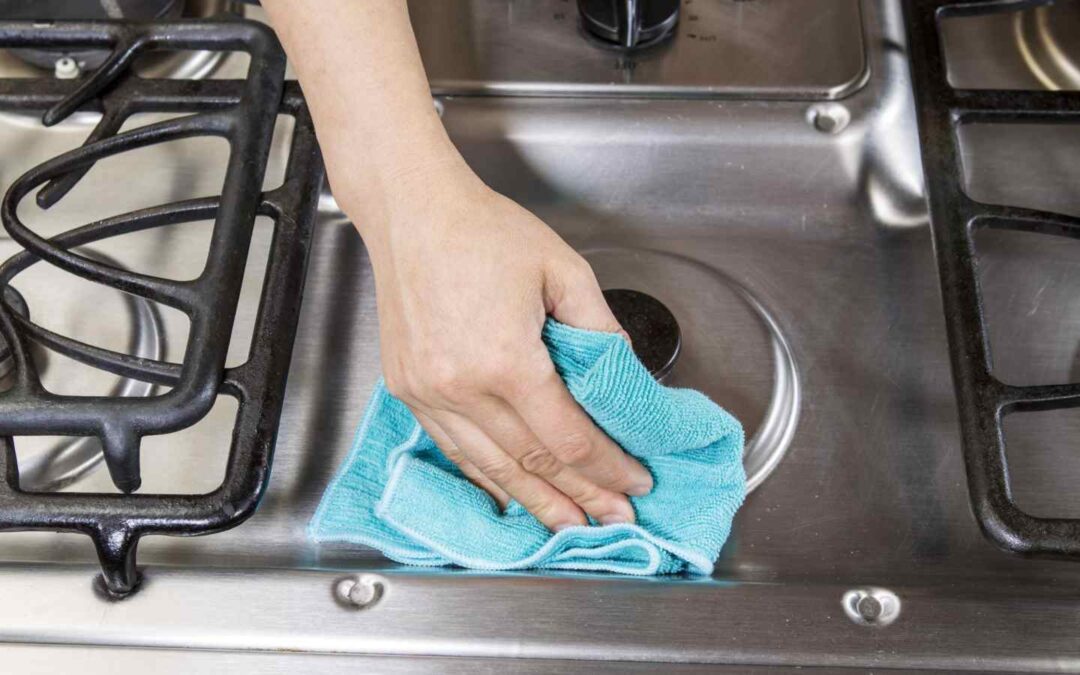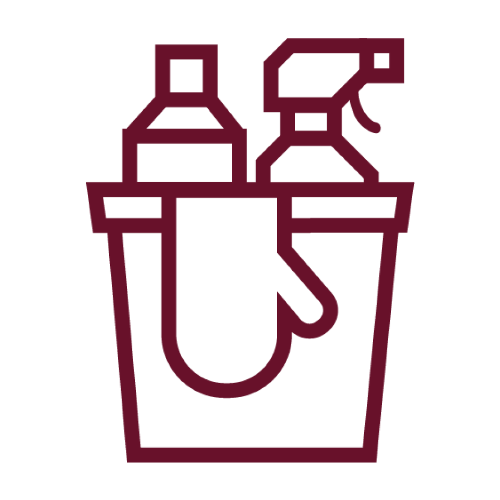Grease stains or stains of any kind, on any surface can be an intimidating problem. They are both unsightly and difficult to remove.
Due to meal preparations involving cooking, sauteing and frying, the kitchen is the most common area in the home where grease stains occur; not only are the spatters of concern, but also the fine mist that gradually collects on walls and other surfaces. The longer grease, and especially cooking grease, is left on any surface, the more difficult it is to remove; over time it tends to gel and bond to the host surface.
No matter what kitchen wall degreaser recipe you are using, the trick to removing grease spots and stains from your kitchen walls is to use warm water to soften up the built-up grime.
So what to do about stain and grease removal?
Wall Stain and Grease Cleaning Tips
1. On Removing Oil Stains from Kitchen Walls
Once the grease is loosened, use your favorite cleanser to remove the grease splatters, and dry to prevent any leftover residue from attracting new dirt.
Homemade Grease Remover Recipe:
- Warm water
- Liquid dish soap
- Baking soda
- White vinegar
- Sponge
- Spray bottle
Blot excess grease or oil with paper towels or napkins. Soak a rag in warm water, wring out the excess water and wipe away the grease. Fill the kitchen sink with hot water then add two drops of dishwashing liquid.
Dunk the sponge in the soapy water and wring out excess liquid. Use a circular motion to scrub the grease stains on the wall tiles. If grease is still present after using liquid dish soap, you need a stronger cleaning agent.
Create a baking soda grease stain remover by combining one cup of baking soda with one cup of warm water. Apply the paste to the stubborn stains with a cloth and rinse clean with a clean rag.
If all else fails, create a heavy duty grease remover spray by combining equal parts vinegar and water. Spray the solution directly onto stains and allow to sit for five minutes. Wipe clean with a rag.
Once grease stains are gone, dry the wall tiles with a clean towel. This method is safe to use on any surface in your kitchen, including how to clean grease off kitchen cabinets, laminate, painted surfaces, appliances, the floors, etc.
Ready To Get Started?
2. If Homemade Grease Remover Does Not Work, Try Using a DIY Magic Eraser
Your hands leave behind greasy, oily fingerprints on every surface you touch, including the ones in your kitchen. Using this DIY cleaner for your kitchen and a scrubber sponge, you will save time and money compared to buying ones from the store.
Our Homemade Cleaning Sponge (Grease and Stain Eraser)
- 1 cup ammonia
- ½ cup vinegar
- ¼ cup baking soda
- 1-gallon warm water
- Sponge
For cleaning walls with vinegar and these other simple household ingredients, mix the first four ingredients in a large bowl. You can use either apple cider vinegar or distilled white vinegar and achieve the same results.
Dip your sponge in the solution and gently rub the grease marks. Do not use a lot of pressure, as you don’t want to take any paint off your walls. When the stain is removed, rinse with warm water and a clean towel.
3. On Cleaning Semi Gloss Painted Walls
Grease isn’t as likely to stick to semi gloss painted kitchen walls, but you still need to be careful when cleaning up the oil to avoid rubbing away the paint or ruining the finish. Begin cleaning semi-gloss walls with a gentle cleanser; many times, hot water is more than enough to do the trick.
If hot water and a cloth aren’t enough, create a cleaner by mixing one ounce of your favorite non abrasive cleaning products with a gallon of hot water. This is also an excellent cleaner for cleaning grout between kitchen tiles.
For stubborn grease stains, you need a stronger solution. To increase the strength, add 1/2 cup of vinegar to your cleaning solution. If that is still not strong enough to cut through the grease, add ¼ cup of baking soda and 1 cup of ammonia.
No matter which recipe you use, apply liberally to the stains with a sponge and rub gently. Always rinse the area well with clean water and a cloth and dry after rinsing.
4. Degreasing Countertops, Splashes, and other Cooking Surfaces
Yes, you can use a commercial degreaser to clean grease off walls and from your countertops and stovetops, but why use commercial products with harsh chemicals when full-strength vinegar does the job just as quickly? Spray all of your kitchen surfaces with undiluted vinegar and allow to sit for at least five minutes.
Wipe down the cooking surfaces with a damp cloth to remove the grease. Make sure to rinse the cloth out occasionally. Pure vinegar also makes an excellent kitchen grout cleaner.
Common Household Cleaning Ingredients You Probably Have
White Vinegar: Mix one part white vinegar with one part hot water. Use a spray bottle to apply the solution to the grease. Allow it to set for several minutes and then wipe with a clean rag. Work in small areas and repeat as many times as necessary to get the wall clean. If the area is large, use several rags to collect the grease.
Baking soda: Make a paste of three tablespoons of baking soda with one cup of warm water. Work the paste into the grease stain. Gently rub the area with a nylon scrubber until the stain disappears. Wipe clean with a clean damp rag.
Ammonia: Mix two cups of household ammonia with one gallon of hot water. Use a spray bottle to apply the solution and scrub with a nylon sponge or brush to remove the stains. Gloves and ventilation are a must when using ammonia.
TSP (Trisodium Phosphate): TSP is a strong cleaner. It can cause irritation and even burn if it is used incorrectly. Wear rubber gloves, safety goggles, and long sleeves to protect your skin and eyes. Surfaces outside of the affected area should be protected from TSP splashes as it can discolor or de-gloss paint, wood, and metal. A solution of ¼ cup TSP per gallon of very warm water is a good place to start. For heavy grease build up, increase the ratio to ½ cup TSP per gallon of water. Use a sponge to apply the solution, wringing out the sponge to avoid dripping. Working from the bottom up reduces streaking. Allow the solution to sit on the wall for two minutes to soften the grease before scrubbing with a nylon scrub pad. Rinse the affected area thoroughly as any residue left on the wall could prevent paint from adhering.
Cleaning away at your walls can be an easy task or a terribly tedious walls. For this reason, our cleaning service professionals can help you sanitize, clean, and maintain your walls and finishings.
Contact us to get a free quote today!


